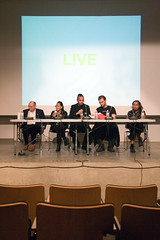Considering Strategies for Political Activism in Art, Oct. 17
More LIVE5: To Art vs. Politics Panel Photo Set
See, we have a problem right off the start--setting up the dialectic of art as separate from political activism. If there's one major theme of this panel, it was that art and activism can exist as an integrated practice, particularly in countries that have a rich history of performative protest.
"If it is true, as Che Guevara, said, that "at the risk of seeming
ridiculous, the true revolutionary is guided by great feelings of love," then let me be bold enough to suggest another ridiculous notion: every act of resistance is a work of art."
--Krystalline Kraus, April 25, 2003
Filipino artists Racquel de Loyola and Mideo Cruz showed us the collaborative workthey have created in the their home country. Racquel de Loyola comes from a dance back ground, but in creating the collaborative works of New World Disorder (http://www.neworldisorder.tk/), she and the other artists draw from other artistic disciplines, as well as religious ceremony and iconography. Striking images of their performance pieces and interventions reveal a wide variety of styles and strategies. De Loyola's costume of multiple bleeding breasts is iconic.
The extraordinary giant effigies that Mideo Cruz helped create collaboratively are an example of the way they use the tradition of creating puppet-like figures (a tradition in religious parades in a region of the Philippines), and subverting them with potent political satire. A giant puppet of President Arroyo has the distorted features in the style of Britain's "Spitting Image" puppets, but this effigy has eight enormous legs, creating an image of the devouring monster the people see her to be. People in the crowds kick and punch the effigies, and in the end set them on fire, protesting the extrajudicial killings devastating the country. The faces of a offending politicians are painted on sculptures of roasted pigs(lechon).
Iwan Wijono, a visiting artist from Java spoke about the integration between art and life on the street in his village. He presented video footage of the PerfURBANce festival he curated in response to the earthquake and tsunami which devastated the village of Dessa Gembengan. At the festival, which took place in April 2006, artists live and eat with the villagers. Each artist is paired with an assistant to help create their work on the site. The video shows us ducks running freely about the streets, and farmers performing the rigorous physical work of harvesting. The work of visiting performance artists is woven between the snake charming, chanting, and other traditional art forms performed by the villagers. Iwan drew from the artist community to help rebuild the bridge and the homes that had been destroyed by the disaster. Furthermore, the visitors' performances seemed to be created in response to the trauma and deaths suffered by the villagers.
The role of the Internet in creating and disseminating politicized art was also discussed briefly. Iwan Wijono introduced himself to Canadian artists from an Internet café across the Pacific Ocean. This lead to a gig in Toronto produced by Fado which lead him the gig performing here at LIVE. De Loyola and Cruz showed us two protest videos out of a 13 created by Filipino artists. These works are banned from being screened in their home country, but can be disseminated widely through YouTube.
Irwin Oostindie is a Vancouver artist/activist and curator. With the DTES Community Arts Network he helped create The MUNCH series taking place this fall, an open discussion group served with food, including topics such as housing local artists (Oct. 22, 5-7 p.m.), a DTES community arts network open house (Oct 29, 4-6 p.m.), and Mark Kuznicki's creative city theories (Nov. 2, 4-7 p.m.) Call Gallery Gachet for more information: (604)687-2468.
Lori Weidenhammer
Subscribe to:
Post Comments (Atom)


No comments:
Post a Comment